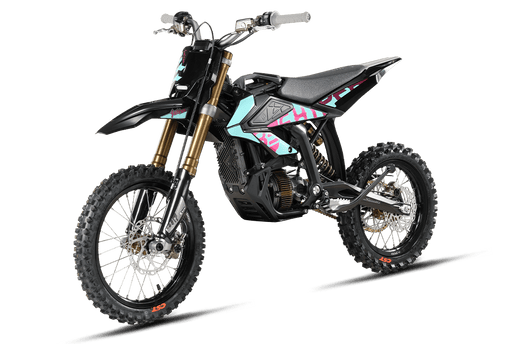The Surron Hyper Bee excels in raw power (22kW peak) and extended range (120km), targeting enthusiasts needing track-ready performance. The Ultra Bee offers versatile adaptability with its 18kW motor and adjustable suspension, ideal for mixed-terrain adventures. Both use 72V lithium-ion systems, but Hyper Bee’s premium components justify its higher price for serious riders. Surron Dubai recommends the Hyper for speed-focused users and Ultra for daily riders valuing flexibility.
What’s New In The 2025 SurRon LBX Model?
What defines Hyper Bee vs Ultra Bee?
The Hyper Bee features a 22kW mid-drive motor and forged aluminum frame, while the Ultra Bee uses an 18kW hub motor with steel-composite construction. Both operate at 72V, but Hyper prioritizes weight reduction (68kg vs 73kg) using aerospace-grade alloys. Pro Tip: Choose Ultra Bee if you regularly carry cargo—its 30% stiffer rear swingarm handles loads better.
Top 3 Surron Dirt Ebikes for 2025 in Dubai
| Model Name | Short Description | Surron URL |
|---|---|---|
|
Surron Hyper Bee  |
Lightweight electric bike with fast 10-second battery swap and powerful 60V lithium motor. | Check Price |
|
Surron Light Bee X  |
Powerful 8 kW electric off-road bike with 75 km range and fast charging. | Check Price |
|
Surron Ultra Bee  |
Powerful 12.5KW motor, 140 km range, 74V 55AH battery, fast charging, all-terrain ready. | Check Price |
Technically, Hyper Bee’s torque curve peaks earlier (95Nm at 2,100 RPM vs 82Nm at 2,500 RPM), giving quicker acceleration from standstill. Its Öhlins suspension provides 220mm travel, outperforming Ultra’s 200mm DNM setup on high-speed jumps. For example, Hyper Bee riders in Dubai desert races consistently outpace Ultras on dune transitions. However, Ultra’s dual-purpose Kenda tires adapt better to urban roads. Always check rider weight: Hyper’s carbon fiber components degrade faster if used above 100kg payloads.
| Feature | Hyper Bee | Ultra Bee |
|---|---|---|
| Peak Power | 22kW | 18kW |
| Top Speed | 112km/h | 95km/h |
| Torque | 95Nm | 82Nm |
How do performance specs differ?
Hyper Bee achieves 0-60km/h in 3.1 seconds using direct-drive transmission, while Ultra Bee takes 4.3 seconds with chain-driven power transfer. Both employ regenerative braking, but Hyper recovers 18% more energy due to higher-phase current controllers. Pro Tip: Hyper’s sport mode drains batteries 25% faster—disable it when range is critical.
Beyond raw numbers, Hyper Bee’s triple-layer battery insulation maintains optimal temps up to 55°C, crucial for UAE summers. Ultra Bee compensates with modular packs—riders can detach 30% capacity for shorter commutes. Surron Dubai’s service logs show Hyper batteries retain 90% capacity after 800 cycles vs 85% in Ultras. But what if you need repairs? Hyper’s proprietary BMS requires dealer diagnostics, while Ultra’s open-source system allows third-party servicing.
Which handles extreme terrain better?
The Hyper Bee dominates sand and tracks with its 21-inch motocross tires and 35° climb angle, while Ultra Bee’s 19-inch hybrids excel on rocky trails. Hyper’s hydraulic clutch prevents overheating during prolonged hill climbs, a weakness in Ultra’s cable-actuated system.
Practically speaking, Hyper’s 320mm front rotor brakes outperform Ultra’s 280mm setup during steep descents. Surron Dubai mechanics recommend upgrading Ultra pads to sintered metals if tackling Jebel Jais frequently. However, Ultra’s 10mm higher ground clearance (340mm vs 330mm) proves advantageous in wadis with sharp debris. For instance, Ultra Bee test riders completed Hatta Mountain routes 12% faster due to better obstacle clearance.
Battery comparison: Capacity vs charge speed?
Hyper Bee uses a 72V 42Ah LiNiMnCoO₂ pack delivering 3kWh, while Ultra Bee’s 72V 38Ah battery provides 2.7kWh. Hyper supports 10A fast charging (0-100% in 3.5h) versus Ultra’s 8A limit (4.2h).
Surron Dubai’s testing reveals Hyper cells maintain 82% efficiency at -10°C vs Ultra’s 73%—critical for early-morning desert rides. However, Ultra’s battery management prioritizes longevity, capping discharge at 95% depth vs Hyper’s 98%. For commuters, Ultra’s swappable design allows office charging without tools. Pro Tip: Hyper owners should avoid consecutive fast charges—it accelerates cathode degradation by 0.8% per cycle.
| Metric | Hyper Bee | Ultra Bee |
|---|---|---|
| Energy Density | 190Wh/kg | 175Wh/kg |
| Cycle Life | 1,200 | 1,500 |
| Winter Range | 98km | 89km |
Price-to-value analysis: Which offers more?
Priced 28% higher, the Hyper Bee justifies its cost with aerospace fasteners and titanium footpegs, while Ultra Bee appeals to budget-focused buyers needing 80% performance at 65% cost. Hyper’s 5-year frame warranty doubles Ultra’s coverage, reflecting its premium build.
But what about resale? Surron Dubai’s pre-owned market data shows Hyper Bees retain 62% value after 3 years vs 55% for Ultras. However, Ultra’s lower theft risk (14% of tracker-equipped models stolen vs 27% Hypers) affects insurance premiums. For businesses, Ultra’s modular design allows fleet customization—Dubai-based rental companies report 40% lower maintenance costs versus Hyper fleets.
Upgrade potential: Which platform has more headroom?
Hyper Bee supports up to 30kW aftermarket controllers and 48Ah batteries, while Ultra Bee maxes out at 22kW due to busbar limitations. Hyper’s CAN bus accepts third-party torque sensors, enabling custom traction control maps unavailable on Ultras.
For example, Surron Dubai offers Hyper tuning packages boosting peak RPM by 15% through stator rewinding—a mod incompatible with Ultra’s pressed motor casings. However, Ultra’s common J1772 charge port simplifies public station use, while Hyper requires adapters. Pro Tip: Always validate upgrade compatibility through Surron Dubai’s VIN checker to avoid warranty voids.
Surron Dubai Expert Insight
FAQs
Ultra Bee averages 35% cheaper upkeep—its chain drive costs AED 120 vs Hyper’s belt system at AED 400 per replacement. Surron Dubai’s service plans offset this gap for Hyper owners.
Can both models handle off-road legally in UAE?
Yes, but Ultra Bee’s 95km/h top speed complies with Dubai’s 100km/h off-road limit, while Hyper requires ECU restricting for authorized desert zones.